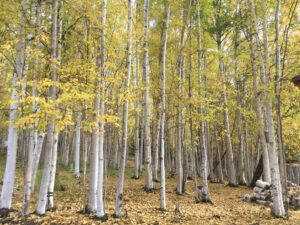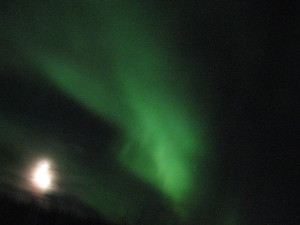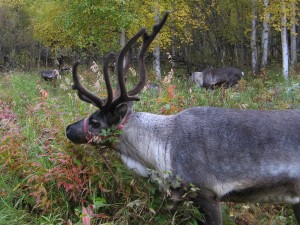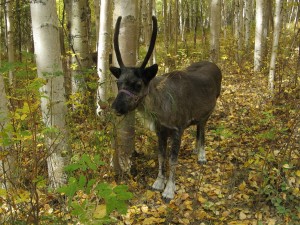My twenty-ninth farm was Running Reindeer Ranch in Fairbanks, Alaska.
The Farm
The farmers are Jane and Doug. Jane is from Alaska. Doug is from Oregon. They’d known each other for years before they happen to meet again when they were both newly single. A relationship blossomed, and they decided to settle in Fairbanks. Jane worked as a nurse, and Doug is the director of an advocacy group for disabled people. At the beginning of their time in Fairbanks, Jane focused on raising her family and her garden. Vegetables grow luxuriously in the long Alaskan summers. But once the reindeer entered the family’s life, they became the focus. One day someone asked if it was possible to tour the farm. Jane was surprised and intrigued that people were interested in the reindeer. A business was born. For a few years, Jane gave nearly daily tours while working full-time as a nurse. She quit nursing over a year ago to focus on the business. In 2016 Jane and Doug went to Mongolia to learn about reindeer. Mongolians, like Jane and Doug, don’t eat their reindeer. Instead they use them for riding, transport, and milking. Reindeer milk is 22% fat, which delighted Doug when he unknowingly put some in his coffee. Jane is teaching Jasper and Rocket to pull a sled.
At the time I was on the farm, they had seven reindeer: Daisy, Jasper (who wanted to kill me), Rocket (my favorite), Olive (the matriarch), Margarita (the baby),Buttercup, and Rufus (Olive’s enemy).
My Experience
“I can assure you grandma didn’t get run over by a reindeer. It was a caribou. Reindeer stop on a dime when they run towards you. Caribou will run you over.” Jane
Reindeer will whonk you with their antlers or smack you with a hoof. My first day at the reindeer ranch I met Jasper, a 750-pound neutered male and Jane’s heart throb. The reindeer were lounging around the white birch trees in their spacious pen when I walked in. Jane was talking and leading the way. From the corner of my eye I saw a rack of antlers rising high above me. Jasper was at my side and not happy. He brought his antlers down in a threatening way to scare me. It worked; I jumped. Jane clapped her hands and yelled. Jasper backed off. “You just have to show him some attitude,” Jane advised. “Take your hands out of your pockets. You look weak.” I suspected I’d need more than a good swagger to get Jasper under my control.
The focus of the farm is the almost daily walks with the reindeer. Jane has reached the number two position for Things to Do in Fairbanks on Trip Advisor. “Some people aren’t sure if reindeer are real,” Jane mentioned. “There’s something mysterious and magical about them.” The tours are usually full. Even when it’s forty below zero. Jane has extra clothes if guests come unprepared for the cold.
The tours start with the story of getting reindeer. Jane’s daughter Robin wanted an animal for a 4-H project. Jane is allergic to horses. Goats are too much work. Sheep are just a no. Cows? You’re kidding. There seemed to be nothing left. One day Jane and Robin were at the University of Fairbanks Large Animal Research Center learning about reindeer. Back in the car, Jane muttered to herself, “What about reindeer?” Robin heard her and responded, “Yes!” Reindeer are not cheap. A farm in Palmer, Alaska offered Robin two reindeer at $2,000 apiece. How does a kid raise money? Robin decided to bake cookies. It worked; she eventually raised enough to buy one reindeer. Money flowed in from another source and she got her two reindeer, Ruby and Willow. However, reindeer are homebodies and don’t like to move. When a tree branch knocked part of a fence down, the reindeer set off back to Palmer. Fortunately, it had snowed. Jane and her friends followed the tracks for three days until they found them. A cowboy happened to be with a group of men working nearby. The reindeer were lassoed up and taken back to their new home. Robin needed a name for her 4-H project and decided on Running Reindeer Ranch.
During the walk through the forest, Jane tells interesting facts about reindeer and caribou. While both are in the deer family and actually the same species, they are distinctly different. Caribou aren’t homebodies. They have the longest land migration, traveling 3,000 miles a year in search of lichen and grasses on the tundra. In the winter, they use their hooves to dig away the snow to find edible plants. Caribou is the French spelling of a Native Mi’kmaq word meaning one who paws the ground. They are wild animals, bigger and leaner than reindeer. Reindeer are barrel-bodied and raised for food. They have been domesticated for over 4,000 years. Caribou are native to Alaska. Reindeer were brought to Alaska from Siberia in the late 1800s to help feed the Natives since the whaling industry had decimated their traditional food source.
Caribou and reindeer are the only deer where both males and females have antlers. The antlers are shed in the spring and new ones rapidly begin growing. While the antlers are growing, they are highly vascularized and sensitive. They don’t like them to be touched. By autumn the antlers have hardened, and the velvet falls off. The antlers are used for herd politics, not fighting. Jane’s reindeer were jousting amongst each other and occasionally bonking me with them too.
Their fur was starting to get patches of white. In the winter the fur of both caribou and reindeer becomes white. These hollow hairs give insulation and allow them to float well while swimming. Reindeer have thicker fur and feel quite comfortable at minus 40 degrees Fahrenheit.
This thicker fur doesn’t keep the bugs off Olive, the new herd queen. If a door is left open during bug season, she goes straight into the house. Jane will be giving a tour and see Olive standing in her bedroom. Or, later, find Olive curled up on the dog bed behind the piano. “She hates bugs,” Jane says in an understatement.
“Up on the housetop, click, click, click… You know Santa was using reindeer.” Jane.
Reindeer make a clicking sound when they walk. They are fast runners and form a line when attacked, with the fastest runners in the lead. They curve and form a double circle, protecting the fastest runners on the inside and leaving the slower ones to their luck on the outside. Caribou scatter when attacked; each deer for itself.
Jane is a serious business woman. Her tours are rated as the number two thing to do in Fairbanks on Trip Advisor which brings in customers. It’s important that the tours go well so she doesn’t lose that rating. During the tours, the assistants’ role is to show people to the bathroom, make sure no one wanders off, keep an eye out for Jasper, put out the cookies and drinks, and clean up after everyone has left. The cookie recipe is a secret. Jane makes them the morning of each tour. If she were away and the tour time was getting near, we worried about the cookies.
 I was there at the beginning of September. The skies were blue and the sun had warmth. But autumn had arrived. The long days of summer were quickly shortening. Twilight evening walks with the dogs at nine when I first arrived became star-spangled strolls under a deep-dark sky two weeks later. The birch trees were golden and carpeting the sparse forest floor. Down by the bog, the tamarack needles were yellow. My task on the farm was to prepare the garden for winter. But there hadn’t been a frost yet. It was a late harvest with raspberries and vegetables still producing. But the time for aurora viewing had returned.
I was there at the beginning of September. The skies were blue and the sun had warmth. But autumn had arrived. The long days of summer were quickly shortening. Twilight evening walks with the dogs at nine when I first arrived became star-spangled strolls under a deep-dark sky two weeks later. The birch trees were golden and carpeting the sparse forest floor. Down by the bog, the tamarack needles were yellow. My task on the farm was to prepare the garden for winter. But there hadn’t been a frost yet. It was a late harvest with raspberries and vegetables still producing. But the time for aurora viewing had returned.
You need sparkling clear dark skies and no pollution to see the aurora. Fairbanks is a prime location to see it. However, it’s hard to get out of a warm bed at two in the morning. After hearing reports of a wonderful light show the previous night, I was determined to kick myself out of bed. I set an alarm. Aft er a few nights of venturing out to the front yard to see nothing, I learned about notification apps that would bing me when a sighting was likely. It’s possible to forecast each night’s aurora’s intensity. A level 5 or higher meant that there would be a good show if the skies were clear. I again tiptoed down the creaky stairs hoping not to wake anyone. This time when I stood in the front yard, above the tall trees I saw what looked like white sand blowing across the sky. There were no greens or reds, just undulating bands of white. (Cameras are much more sensitive to colors than our eyes. I was told young eyes can see light greens.) The shapes and movement were mesmerizing. The aurora will appear for a while and then disappear. Timing is everything. When the show was over after about ten minutes, I tiptoed back to my warm bed. Even more useful than the app, was the live Murphy Dome webcam. The farm was on the road leading to the top of Murphy Dome, so if the webcam showed an aurora, I could see it at the farm too. I became addicted to checking it. I’d set an alarm, switch on my iPad, and check the view. If there was a green sky, I was out of bed. The front yard was not the best place to see the lights. The other WWOOFer and I took a couple of trips to the top of Murphy Dome to get an unobstructed view. While the view was good, the other cars, voices, and flashlights took away from the experience. However, the aurora appeared out the side car window on our way back home. We stopped and got out. Quiet Alaska forest around us, the magical lights above. I certainly felt a spiritual, wild, connection with nature. This was the ultimate aurora experience!
er a few nights of venturing out to the front yard to see nothing, I learned about notification apps that would bing me when a sighting was likely. It’s possible to forecast each night’s aurora’s intensity. A level 5 or higher meant that there would be a good show if the skies were clear. I again tiptoed down the creaky stairs hoping not to wake anyone. This time when I stood in the front yard, above the tall trees I saw what looked like white sand blowing across the sky. There were no greens or reds, just undulating bands of white. (Cameras are much more sensitive to colors than our eyes. I was told young eyes can see light greens.) The shapes and movement were mesmerizing. The aurora will appear for a while and then disappear. Timing is everything. When the show was over after about ten minutes, I tiptoed back to my warm bed. Even more useful than the app, was the live Murphy Dome webcam. The farm was on the road leading to the top of Murphy Dome, so if the webcam showed an aurora, I could see it at the farm too. I became addicted to checking it. I’d set an alarm, switch on my iPad, and check the view. If there was a green sky, I was out of bed. The front yard was not the best place to see the lights. The other WWOOFer and I took a couple of trips to the top of Murphy Dome to get an unobstructed view. While the view was good, the other cars, voices, and flashlights took away from the experience. However, the aurora appeared out the side car window on our way back home. We stopped and got out. Quiet Alaska forest around us, the magical lights above. I certainly felt a spiritual, wild, connection with nature. This was the ultimate aurora experience!
Jane and Doug liked to chat during dinner time. They talked about their trips to Africa and Mongolia. I was surprised they were able to take long trips since the other farmers I’ve met have had to stop traveling because they need to have someone to care for their animals. Farm sitters are hard to find. “We have running water and most of the people up the hill don’t,” Jane told me. “People are happy to feed our reindeer in exchange for a flush toilet and a hot shower.” Jane also expressed her worries about climate change, which is particularly noticeable in Alaska. Animals migrate by sunlight. Plants grow by sunlight. Ptarmigan feathers change from dark to white by the sunlight. The amount of sunlight through the seasons stays constant, but the weather is warming. What will happen if the ptarmigan change to white but it hasn’t snowed yet? The permafrost is already starting to melt. Glaciers are receding at a quick pace. Climate change is starting to take a toll in Alaska.
There was plenty to do around Fairbanks on my time off. Chena Hot Springs has steamy outdoor pools. I bet it would be a prime spot for viewing the aurora. I also took a riverboat tour down the Chena River. Along the way we saw a bush pilot demonstration, Susan Butcher’s kennels (She was the first woman to win the Iditarod.), and a representation of a Chena Indian village with Native guides. Alaska is also a good place for beer. I frequented HooDoo right in the middle of Fairbanks, and also ventured out to Silver Gulch in the tiny town of Fox. Silver Gulch is the most northern brewery in the U.S., at least for now.
I was surprised at how much I liked Fairbanks. I had chosen to go there because I wanted to see the middle of Alaska. I had no notion of what it would look like. I found I like the pipe-cleaner-shaped black spruce trees poking up through the bogs, and the yellow aspens carpeting the dome-shaped hillsides. The town is small with a large university. The students like to don bathing suits in front of the university’s sign board when it shows the temperature in negative numbers. I’m not sure what I’d think of the winters, but Fairbanks was certainly a fine place to be in late summer.


